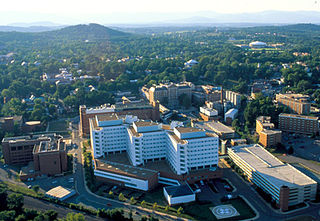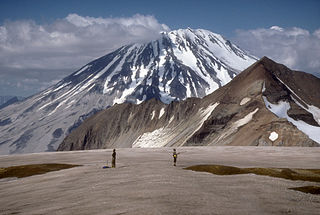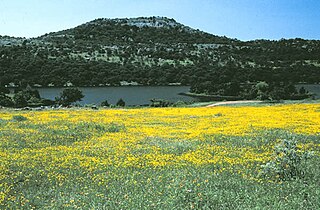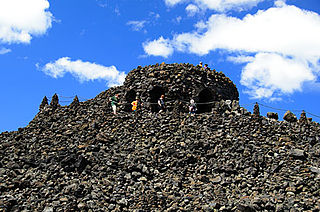| Mount Jefferson | |
|---|---|
| Highest point | |
| Elevation | 846 ft (258 m) [1] |
| Coordinates | 38°01′58″N78°31′20″W / 38.03278°N 78.52222°W Coordinates: 38°01′58″N78°31′20″W / 38.03278°N 78.52222°W [1] |
| Geography | |
| Location | Albemarle County, Virginia, U.S. |
| Parent range | Ragged Mountains |
| Topo map | USGS Charlottesville West |
Mount Jefferson is a mountain located just outside Charlottesville, Virginia, United States, in Albemarle County. It lies south of Lewis Mountain, and is positioned at the northeastern edge of the Ragged Mountains.

A mountain is a large landform that rises above the surrounding land in a limited area, usually in the form of a peak. A mountain is generally steeper than a hill. Mountains are formed through tectonic forces or volcanism. These forces can locally raise the surface of the earth. Mountains erode slowly through the action of rivers, weather conditions, and glaciers. A few mountains are isolated summits, but most occur in huge mountain ranges.

Charlottesville, colloquially known as C'ville and officially named the City of Charlottesville, is an independent city in the Commonwealth of Virginia. It is the county seat of Albemarle County, which surrounds the city, though the two are separate legal entities. This means a resident will list Charlottesville as both their county and city on official paperwork. It is named after the British Queen consort Charlotte of Mecklenburg-Strelitz, who as the wife of George III was Virginia's last Queen. In 2016, an estimated 46,912 people lived within the city limits. The Bureau of Economic Analysis combines the City of Charlottesville with Albemarle County for statistical purposes, bringing its population to approximately 150,000. Charlottesville is the heart of the Charlottesville metropolitan area, which includes Albemarle, Buckingham, Fluvanna, Greene, and Nelson counties.

Albemarle County is a county located in the Piedmont region of the Commonwealth of Virginia. Its county seat is Charlottesville, which is an independent city and enclave entirely surrounded by the county. Albemarle County is part of the Charlottesville Metropolitan Statistical Area. As of the 2010 census, the population of Albemarle County was 98,970, more than triple the 1960 census count.
It was named Mount Jefferson in honor of Thomas Jefferson after the establishment of the Leander McCormick Observatory on the summit in 1885. Jefferson had urged the purchase of the mountain for the University of Virginia, in part because of its suitability as a site for an observatory. In addition, he valued it for the water resources and the abundance of timber for construction of the university.

Thomas Jefferson was an American statesman, diplomat, lawyer, architect, and Founding Father who served as the third president of the United States from 1801 to 1809. Previously, he had served as the second vice president of the United States from 1797 to 1801. The principal author of the Declaration of Independence, Jefferson was a proponent of democracy, republicanism, and individual rights, motivating American colonists to break from the Kingdom of Great Britain and form a new nation; he produced formative documents and decisions at both the state and national level.

The University of Virginia is a public research university in Charlottesville, Virginia. It was founded in 1819 by Declaration of Independence author and former President Thomas Jefferson. UVA is the flagship university of Virginia and a UNESCO World Heritage Site. It is known for its historic foundations, student-run honor code, and secret societies.

Water is a transparent, tasteless, odorless, and nearly colorless chemical substance, which is the main constituent of Earth's streams, lakes, and oceans, and the fluids of most living organisms. It is vital for all known forms of life, even though it provides no calories or organic nutrients. Its chemical formula is H2O, meaning that each of its molecules contains one oxygen and two hydrogen atoms, connected by covalent bonds. Water is the name of the liquid state of H2O at standard ambient temperature and pressure. It forms precipitation in the form of rain and aerosols in the form of fog. Clouds are formed from suspended droplets of water and ice, its solid state. When finely divided, crystalline ice may precipitate in the form of snow. The gaseous state of water is steam or water vapor. Water moves continually through the water cycle of evaporation, transpiration (evapotranspiration), condensation, precipitation, and runoff, usually reaching the sea.
Prior to the renaming it had been known as Old Reservoir Mountain and Observatory Mountain (for an observatory which Jefferson directed to be built on the summit), and is now informally known as Observatory Hill.
The mountain is traversed by McCormick Road and Edgemont Road (which also runs along a neighboring ridge — Edgemont or Midmont), and is the site of several other University of Virginia buildings including a deactivated nuclear reactor, a linear accelerator and dormitories. It has been preserved in a largely wooded state for the protection of McCormick Observatory from light pollution. It is used by birdwatchers, mountain bikers, hikers, and students and faculty at The Judge Advocate General's Legal Center and School, U.S. Army, for military physical fitness training. The headquarters for the National Radio Astronomy Observatory are also located on Mount Jefferson.

A nuclear reactor, formerly known as an atomic pile, is a device used to initiate and control a self-sustained nuclear chain reaction. Nuclear reactors are used at nuclear power plants for electricity generation and in nuclear marine propulsion. Heat from nuclear fission is passed to a working fluid, which in turn runs through steam turbines. These either drive a ship's propellers or turn electrical generators' shafts. Nuclear generated steam in principle can be used for industrial process heat or for district heating. Some reactors are used to produce isotopes for medical and industrial use, or for production of weapons-grade plutonium. Research reactors are run only for research. As of early 2019, the IAEA reports there are 454 nuclear power reactors and 226 nuclear research reactors in operation around the world.

A forest is a large area dominated by trees. Hundreds of more precise definitions of forest are used throughout the world, incorporating factors such as tree density, tree height, land use, legal standing and ecological function. According to the widely used Food and Agriculture Organization definition, forests covered 4 billion hectares (9.9×109 acres) (15 million square miles) or approximately 30 percent of the world's land area in 2006.

Light pollution, also known as photopollution, is the presence of anthropogenic light in the night environment. It is exacerbated by excessive, misdirected or obtrusive uses of light, but even carefully used light fundamentally alters natural conditions. As a major side-effect of urbanization, it is blamed for compromising health, disrupting ecosystems and spoiling aesthetic environments.
















